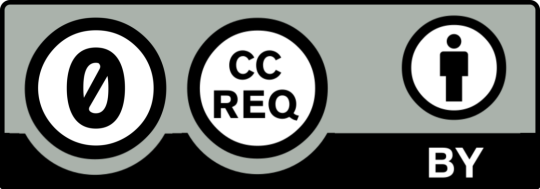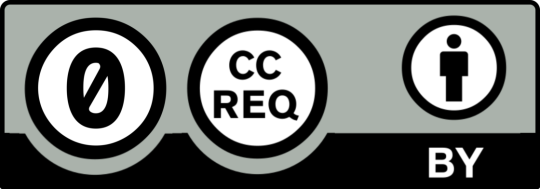This post originally appeared on the Shapeways blog.

Unofficial rendering of a request logo.
My earlier post about the 2017 Creative Commons Summit took stock of the complicated relationship between Creative Commons and the 3D printing community, and the fundamental challenge created by Creative Commons (CC) licenses, which are sometimes meant to be legally binding and sometimes used as non-binding social signals.
Perhaps the most intriguing way to address this challenge was an idea put forward by CC USA’s Meredith Jacob for an approach called Disclaim and Request. The idea is to remove ambiguity around the copyright status of objects by using two symbols: the Creative Commons public domain dedication tool CC0 (that’s the disclaim part) and either a new CC tool or other standard notation to request conditions such as attribution or no derivatives.
A CC REQ logo would clarify that the designer is making a request rather than a legally enforceable demand. In other words, they are only using CC as a social signal.
Disclaim
Because 3D printed works can have both artistic (protected by copyright) and functional (not protected by copyright) elements, they have a complicated relationship with copyright. Between works fully protected by copyright and works that are in no way protected lies a spectrum of works with all kinds of partial copyright protection.
Oftentimes that partial protection would not be enough to prevent a bad actor from copying the core of the object in a way that ignores the conditions of the copyright license. That means a traditional CC license would not end up imposing any enforceable obligations on someone who wanted to avoid the conditions of the license.
However, there could be enough copyright protection to make it hard for a good actor to easily make use of the design without a license. The absence of a clear license would then prevent others from building on the work in a way the creator might support. But there is a constant threat that a conditional license could end up overstating its legal control over the object itself.
In these cases, there is no CC license that can prevent what creators view as bad uses while at the same time avoiding erecting unintentional barriers (in the form of conditions that may baselessly scare away a user) to what creators view as good uses. This is not an ideal outcome.
Additionally, the scope of copyright protection can evolve over time. An object that is beyond the scope of copyright when it is created may be pulled into copyright by subsequent judicial decisions or changes to the law.
A perfect tool to resolve this ambiguity would make it clear that the work is available in the commons without imposing conditions that might either be unenforceable or barriers to good actors.

CC0 is that tool. In this context, using a CC0 license effectively says: I do not think there is anything here that is protected by copyright. However, to the extent that copyright does protect part of this design, I waive those rights.
Affirmatively placing an object in the public domain is the most effective way to clarify the copyright status of the object. While you could use a more traditional CC license (such as a CC BY), the conditions of that license (the BY) assume copyright protection that may not exist. In contrast, CC0 waives all copyright interests without attempting to impose unenforceable conditions if those interests never existed in the first place.
Request
Even when a designer has formally disclaimed any copyright interest with CC0, they may still want to take advantage of the social signals that CC licenses can provide. They might want to ask for attribution, for example, even if they know that request is not legally enforceable.
While a traditional CC license might send those signals, using it only to signal creates all sorts of problems, as I explained in the previous post.
That is where a new CC REQ icon comes in.

Unofficial rendering of a request logo.
CC REQ is meant to communicate two concepts to downstream users:
- that the creator does not believe that they have a legally enforceable copyright interest in the work, but to the extent they exist residually they are disclaimed
- that future users nevertheless should comply with the social norms that have grown up around various CC licenses
While these messages could theoretically be folded into a single icon, combining CC0 with CC REQ makes it clear that creators may be actively waiving any existing copyright protection — an idea that should not be hidden in legal fine print.
Why Would This Work?
Disclaim and request achieves two important goals. First, it clarifies the copyright status of the covered work. In a world of copyright ambiguity, this clarity can be incredibly valuable. In the long term, it is better to have people occasionally give away niggling bits of copyright protection than to occasionally claim copyright control that does not exist. This is because those niggling bits are unlikely to serve as barriers against bad users, but overclaiming rights can freeze out legitimate uses.
Second, disclaim and request maintains the signal communicated by a CC license without undermining its enforceability, allowing good actors to understand and comply with the wishes of creators without overstating the authority that those creators have to enforce those wishes. It further clarifies the rules for everyone, which is something that CC has traditionally excelled at.
What’s Next?
For now, disclaim and request is just a proposal. Creative Commons does amazing work every day with limited resources, which means that it needs to prioritize which projects to focus on. Even in a world of unlimited resources, there is also an argument to be made that CC REQ complicates instead of clarifies the status of the CC licenses by adding yet another icon to the set.
All of which is to say that it is up to Creative Commons what to do with this idea.
In light of that, we very much appreciate CCs engagement with these challenges thus far. We hope to continue the discussion, which includes discussions with all the communities involved. As those discussions evolve we will do our best to document them here on the blog.